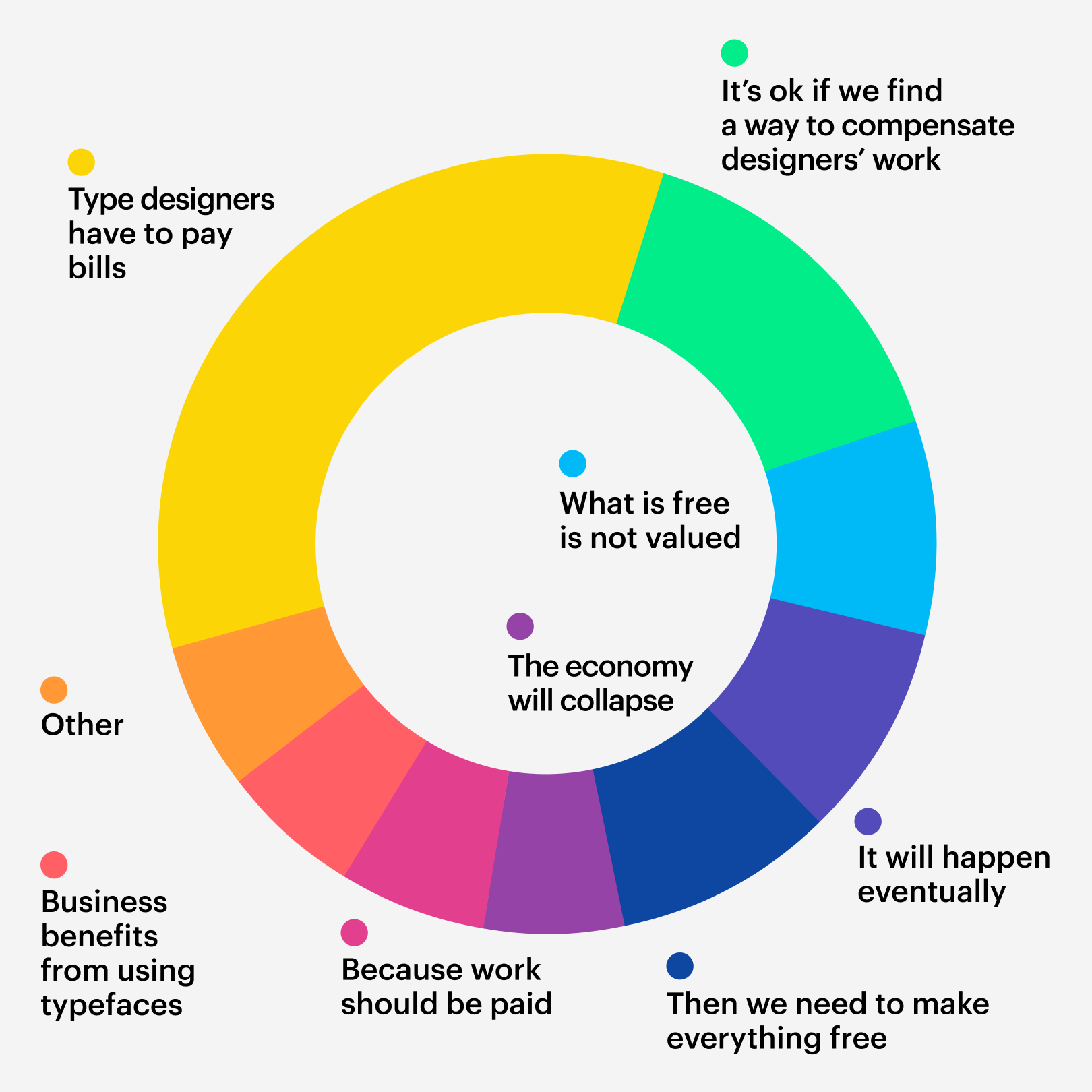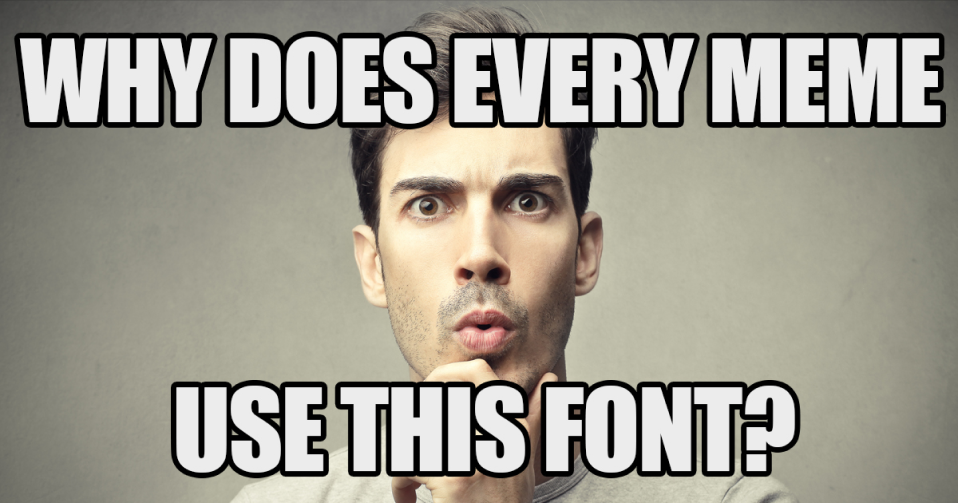Recently, we decided to ask our authors several questions about their work and type design in general. Designers whose fonts are not on our storefront heard about this and asked to participate as well. This is how our small, (un)representative survey came about, exploring what the font community is thinking about and what it looks like today.
We asked designers to respond to 20 questions, none of which were mandatory. All the questions were open, but the responses to many of them were so unanimous that we were able to turn the collected answers into charts, which (along with some of the most interesting answers) we are sharing in this series.
Why not make all the fonts free and open source?

- John Hudson
- Tiro Typeworks, co-founder
I think the type business needs to be a diverse ecosystem, within which there is certainly space for libre fonts, but saying that all fonts should be free makes no more sense than saying no fonts should be free. The people who make any fonts need to be able to make a living from their labour and to benefit financially from the value derived from what they make. These two things, the labour and the value, are not the same, and there is a specific value associated with free fonts. We have clients who pay us to release fonts under libre licenses, and they pay for that value.
- Rutherford Craze
- Mass-Driver, founder
Capitalism. Those who can afford not to make money from type would undermine those that can’t if they released everything for free.
- Vera Evstafieva
- Type designer, calligrapher
Author of Amalta
РThe work of type designers and type technicians has to be paid. Free fonts are great when the project is paid by a company which is going to distribute the font. In other cases, the cost of design is divided between users.
- David Jonathan Ross
- Font of the Month Club, founder
Author of Fit, Forma DJR, Input, Megazoid, Roslindale
In theory, I don’t mind this, if we can find a way to compensate designers for their work. But I will say I really value the relationship I have with folks who have chosen to make purchases from me… I have found it to be more direct and more meaningful than millions of people downloading something of mine for free.
How to sell one’s own typeface?

There’s no simple answer to this question. Selling fonts involves a number of actions across the entire market infrastructure: competitions, marketplaces, blogs. But luck also plays a significant role.
- Adrien Midzic
- Pizza Typefaces, co-founder
Author of Metal
There are two solutions: either enlist help from an established foundry (preferably independent), or ask a friend who can create a web shop, or commission someone to build it.
- Hugues Gentile
- Production Type, senior type designer
Co-author of Signal, Proto Grotesk. Автор Qommodore
I am no specialist in this commercial aspect. But selling typefaces through online shops has become much more accessible. But marketing it properly seems to be harder and harder.
- Jean-Baptiste Levée
- Production Type, founder
Co-author of Tesseract, Spectral, Proto Grotesk
- Purchase an URL.
- Upload your font.
- Set a price.
- Wait for a while.
How many of your sketches end up as a ready-to-use typeface?

Since I’m not done yet, it’s rather hard to say which sketches will never make it. But generally speaking, time is a crucial factor. When something roughly sketched lays around for too long, chances are high it will forever carve out its miserable existence on paper or my hard drives. Some sketches are also fun to explore for a bit and discard later on, or as a learning experience, or as an experiment.
- Marcus Leis Allion
- Type and graphic designer,
researcher, educator
Only about 10% of my sketches end up as typefaces, if that. Sketches are primarily exploratory; some letterforms, while intriguing individually, don’t translate well into full typefaces but may be effective as letter marks or logotypes. Additionally, some sketches that look promising initially lose their appeal when refined and drawn more carefully.
- Tom Holloway
- AKQA, senior experience designer
Type and graphic designer
None. The digitisation process is one of learning about a design system. When I sketch I don’t yet know all the detailed information I will need to consider as I design.
- Rutherford Craze
- Mass-Driver, founder
Maybe 1%? The only way to have good ideas is to have lots of bad ones first.
How would you define the term «personal use of a typeface»?

- Thierry Blancpain
- Grilli Type, co-founder
It’s a useless term in terms of licensing or licensing restrictions and we at Grilli Type avoid it completely. Otherwise, I guess I could take it to mean my own use of my own typefaces.
- John Hudson
- Tiro Typeworks, co-founder
In a legal sense, it doesn’t mean anything. So it isn’t a phrase I would use in something like a user license agreement without clearly defining it. It might mean non-commercial use, but in that case I would say non-commercial use, and explain what that means — and how it differs from commercial use — and provide examples. ‘Personal use’ seems too vague to me.
- Alja Herlah
- Type Salon, co-founder
Co-author of Spektra
One can use a typeface limitlessly, the question is who and where is going to read it.
Could you share your favourite type design meme?

 Shared by Kris Sowersby, founder of Klim Type Foundry
Shared by Kris Sowersby, founder of Klim Type Foundry
 Shared by Emmanuel Besse, co-author of Signal
Shared by Emmanuel Besse, co-author of Signal
 Shared by Olga Pankova, author of Curbe
Shared by Olga Pankova, author of Curbe
 Shared by Anna Seslavinskaya, author of HealthGoth
Shared by Anna Seslavinskaya, author of HealthGoth
 Shared by Fer Cozzi, author of Tomasa
Shared by Fer Cozzi, author of Tomasa
 Shared by Nick Sherman, founder of HEX and co-founder of Fonts In Use
Shared by Nick Sherman, founder of HEX and co-founder of Fonts In Use














